HBS108 Health Information and Data Assignment 1: SSB Consumption Study
VerifiedAdded on 2023/04/10
|6
|1355
|163
Homework Assignment
AI Summary
This assignment analyzes sugar-sweetened beverage (SSB) consumption, drawing on data from the Australian Bureau of Statistics and research findings from peer-reviewed journals. It explores the consumption patterns of SSB among different age groups, particularly focusing on adolescents and adults. The assignment examines various factors influencing SSB intake, including parental control, awareness of health risks, and advertising. It also delves into the implications of SSB consumption, such as potential health consequences and the role of government policies like taxation and regulation. The study incorporates both quantitative and qualitative research methodologies, including hypothesis testing, research questions, and database searches, to provide a comprehensive understanding of the issue. The analysis also includes potential conflicts of interest and recommendations for future research and ethical considerations. The assignment uses references from various sources like the World Health Organization and other academic journals to support the findings and recommendations.
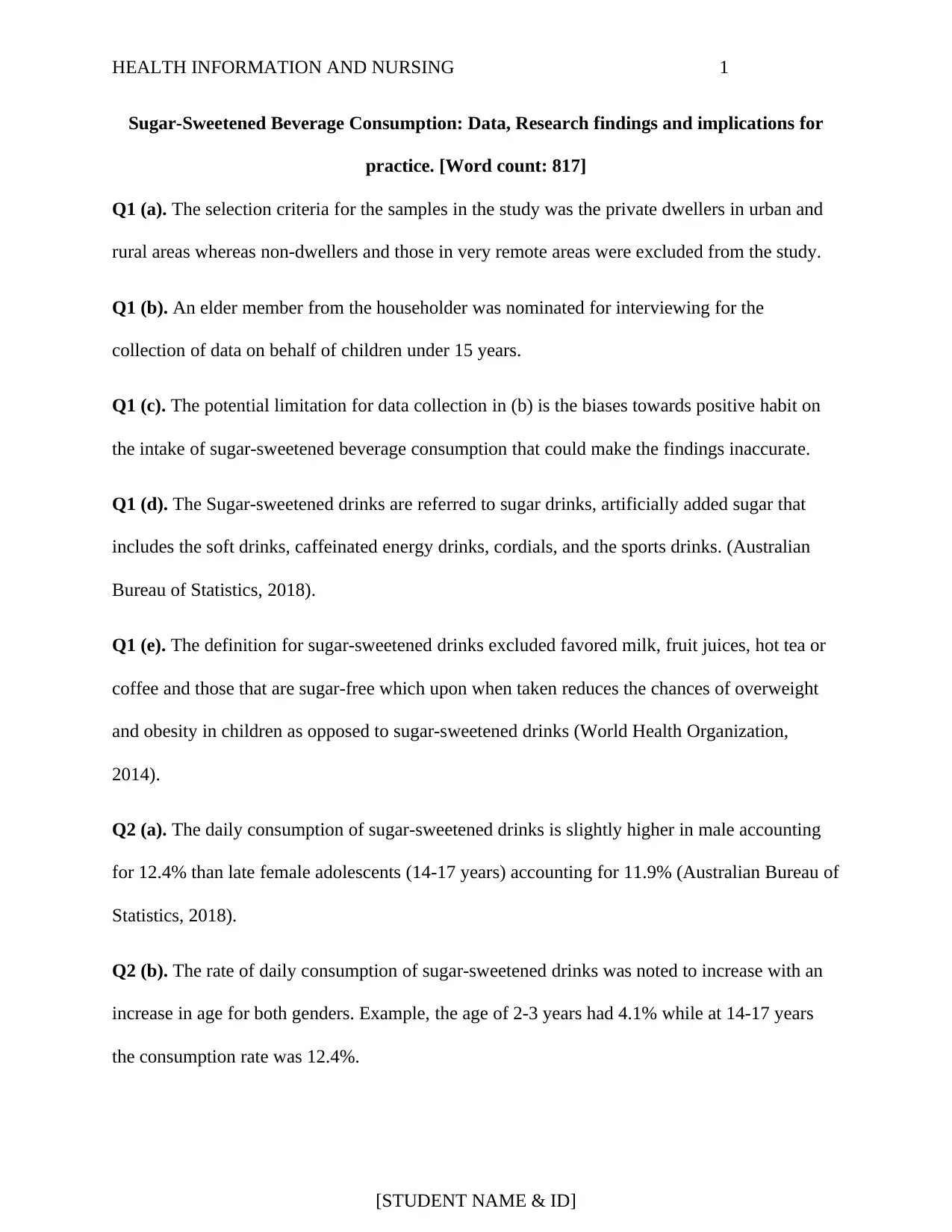
HEALTH INFORMATION AND NURSING 1
Sugar-Sweetened Beverage Consumption: Data, Research findings and implications for
practice. [Word count: 817]
Q1 (a). The selection criteria for the samples in the study was the private dwellers in urban and
rural areas whereas non-dwellers and those in very remote areas were excluded from the study.
Q1 (b). An elder member from the householder was nominated for interviewing for the
collection of data on behalf of children under 15 years.
Q1 (c). The potential limitation for data collection in (b) is the biases towards positive habit on
the intake of sugar-sweetened beverage consumption that could make the findings inaccurate.
Q1 (d). The Sugar-sweetened drinks are referred to sugar drinks, artificially added sugar that
includes the soft drinks, caffeinated energy drinks, cordials, and the sports drinks. (Australian
Bureau of Statistics, 2018).
Q1 (e). The definition for sugar-sweetened drinks excluded favored milk, fruit juices, hot tea or
coffee and those that are sugar-free which upon when taken reduces the chances of overweight
and obesity in children as opposed to sugar-sweetened drinks (World Health Organization,
2014).
Q2 (a). The daily consumption of sugar-sweetened drinks is slightly higher in male accounting
for 12.4% than late female adolescents (14-17 years) accounting for 11.9% (Australian Bureau of
Statistics, 2018).
Q2 (b). The rate of daily consumption of sugar-sweetened drinks was noted to increase with an
increase in age for both genders. Example, the age of 2-3 years had 4.1% while at 14-17 years
the consumption rate was 12.4%.
[STUDENT NAME & ID]
Sugar-Sweetened Beverage Consumption: Data, Research findings and implications for
practice. [Word count: 817]
Q1 (a). The selection criteria for the samples in the study was the private dwellers in urban and
rural areas whereas non-dwellers and those in very remote areas were excluded from the study.
Q1 (b). An elder member from the householder was nominated for interviewing for the
collection of data on behalf of children under 15 years.
Q1 (c). The potential limitation for data collection in (b) is the biases towards positive habit on
the intake of sugar-sweetened beverage consumption that could make the findings inaccurate.
Q1 (d). The Sugar-sweetened drinks are referred to sugar drinks, artificially added sugar that
includes the soft drinks, caffeinated energy drinks, cordials, and the sports drinks. (Australian
Bureau of Statistics, 2018).
Q1 (e). The definition for sugar-sweetened drinks excluded favored milk, fruit juices, hot tea or
coffee and those that are sugar-free which upon when taken reduces the chances of overweight
and obesity in children as opposed to sugar-sweetened drinks (World Health Organization,
2014).
Q2 (a). The daily consumption of sugar-sweetened drinks is slightly higher in male accounting
for 12.4% than late female adolescents (14-17 years) accounting for 11.9% (Australian Bureau of
Statistics, 2018).
Q2 (b). The rate of daily consumption of sugar-sweetened drinks was noted to increase with an
increase in age for both genders. Example, the age of 2-3 years had 4.1% while at 14-17 years
the consumption rate was 12.4%.
[STUDENT NAME & ID]
Paraphrase This Document
Need a fresh take? Get an instant paraphrase of this document with our AI Paraphraser
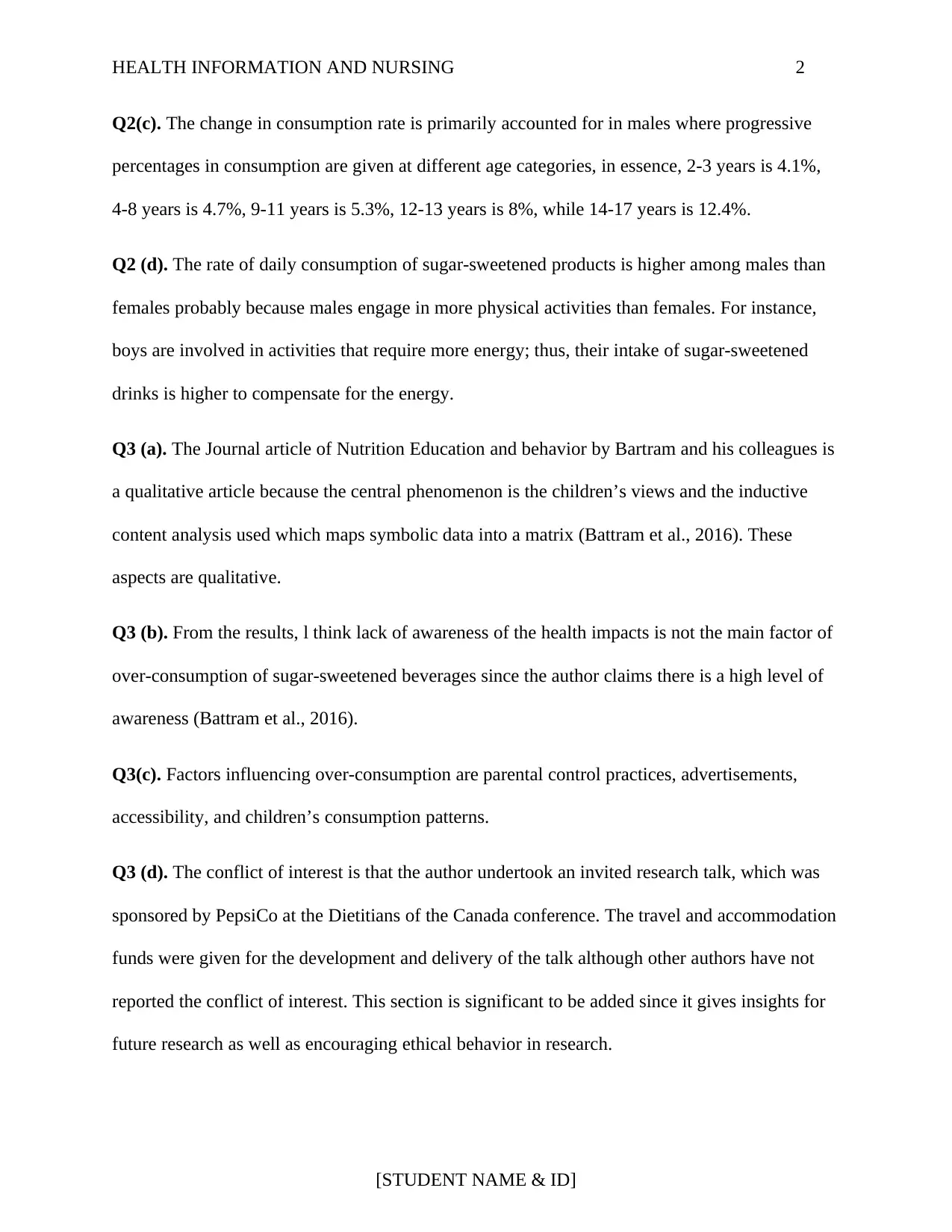
HEALTH INFORMATION AND NURSING 2
Q2(c). The change in consumption rate is primarily accounted for in males where progressive
percentages in consumption are given at different age categories, in essence, 2-3 years is 4.1%,
4-8 years is 4.7%, 9-11 years is 5.3%, 12-13 years is 8%, while 14-17 years is 12.4%.
Q2 (d). The rate of daily consumption of sugar-sweetened products is higher among males than
females probably because males engage in more physical activities than females. For instance,
boys are involved in activities that require more energy; thus, their intake of sugar-sweetened
drinks is higher to compensate for the energy.
Q3 (a). The Journal article of Nutrition Education and behavior by Bartram and his colleagues is
a qualitative article because the central phenomenon is the children’s views and the inductive
content analysis used which maps symbolic data into a matrix (Battram et al., 2016). These
aspects are qualitative.
Q3 (b). From the results, l think lack of awareness of the health impacts is not the main factor of
over-consumption of sugar-sweetened beverages since the author claims there is a high level of
awareness (Battram et al., 2016).
Q3(c). Factors influencing over-consumption are parental control practices, advertisements,
accessibility, and children’s consumption patterns.
Q3 (d). The conflict of interest is that the author undertook an invited research talk, which was
sponsored by PepsiCo at the Dietitians of the Canada conference. The travel and accommodation
funds were given for the development and delivery of the talk although other authors have not
reported the conflict of interest. This section is significant to be added since it gives insights for
future research as well as encouraging ethical behavior in research.
[STUDENT NAME & ID]
Q2(c). The change in consumption rate is primarily accounted for in males where progressive
percentages in consumption are given at different age categories, in essence, 2-3 years is 4.1%,
4-8 years is 4.7%, 9-11 years is 5.3%, 12-13 years is 8%, while 14-17 years is 12.4%.
Q2 (d). The rate of daily consumption of sugar-sweetened products is higher among males than
females probably because males engage in more physical activities than females. For instance,
boys are involved in activities that require more energy; thus, their intake of sugar-sweetened
drinks is higher to compensate for the energy.
Q3 (a). The Journal article of Nutrition Education and behavior by Bartram and his colleagues is
a qualitative article because the central phenomenon is the children’s views and the inductive
content analysis used which maps symbolic data into a matrix (Battram et al., 2016). These
aspects are qualitative.
Q3 (b). From the results, l think lack of awareness of the health impacts is not the main factor of
over-consumption of sugar-sweetened beverages since the author claims there is a high level of
awareness (Battram et al., 2016).
Q3(c). Factors influencing over-consumption are parental control practices, advertisements,
accessibility, and children’s consumption patterns.
Q3 (d). The conflict of interest is that the author undertook an invited research talk, which was
sponsored by PepsiCo at the Dietitians of the Canada conference. The travel and accommodation
funds were given for the development and delivery of the talk although other authors have not
reported the conflict of interest. This section is significant to be added since it gives insights for
future research as well as encouraging ethical behavior in research.
[STUDENT NAME & ID]
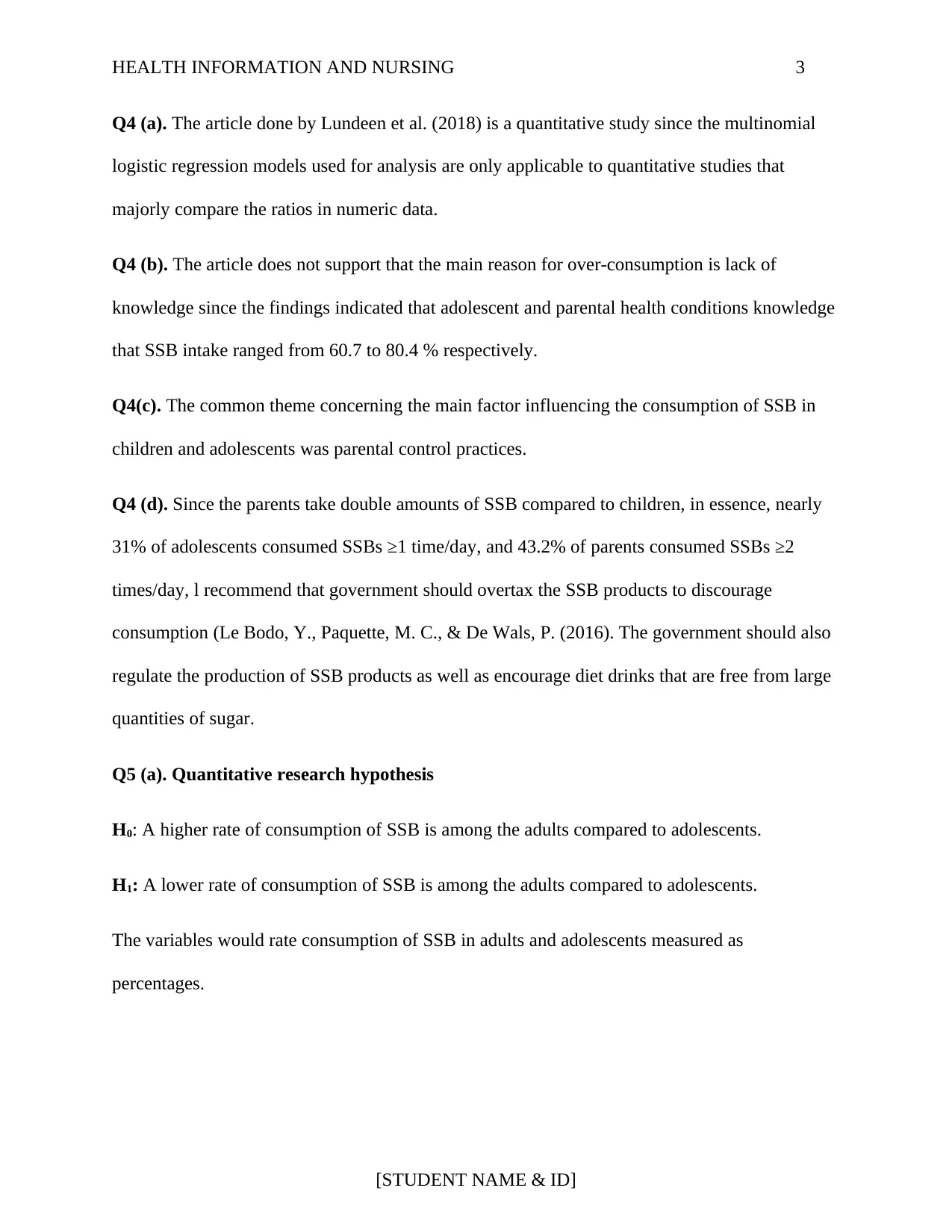
HEALTH INFORMATION AND NURSING 3
Q4 (a). The article done by Lundeen et al. (2018) is a quantitative study since the multinomial
logistic regression models used for analysis are only applicable to quantitative studies that
majorly compare the ratios in numeric data.
Q4 (b). The article does not support that the main reason for over-consumption is lack of
knowledge since the findings indicated that adolescent and parental health conditions knowledge
that SSB intake ranged from 60.7 to 80.4 % respectively.
Q4(c). The common theme concerning the main factor influencing the consumption of SSB in
children and adolescents was parental control practices.
Q4 (d). Since the parents take double amounts of SSB compared to children, in essence, nearly
31% of adolescents consumed SSBs ≥1 time/day, and 43.2% of parents consumed SSBs ≥2
times/day, l recommend that government should overtax the SSB products to discourage
consumption (Le Bodo, Y., Paquette, M. C., & De Wals, P. (2016). The government should also
regulate the production of SSB products as well as encourage diet drinks that are free from large
quantities of sugar.
Q5 (a). Quantitative research hypothesis
H0: A higher rate of consumption of SSB is among the adults compared to adolescents.
H1: A lower rate of consumption of SSB is among the adults compared to adolescents.
The variables would rate consumption of SSB in adults and adolescents measured as
percentages.
[STUDENT NAME & ID]
Q4 (a). The article done by Lundeen et al. (2018) is a quantitative study since the multinomial
logistic regression models used for analysis are only applicable to quantitative studies that
majorly compare the ratios in numeric data.
Q4 (b). The article does not support that the main reason for over-consumption is lack of
knowledge since the findings indicated that adolescent and parental health conditions knowledge
that SSB intake ranged from 60.7 to 80.4 % respectively.
Q4(c). The common theme concerning the main factor influencing the consumption of SSB in
children and adolescents was parental control practices.
Q4 (d). Since the parents take double amounts of SSB compared to children, in essence, nearly
31% of adolescents consumed SSBs ≥1 time/day, and 43.2% of parents consumed SSBs ≥2
times/day, l recommend that government should overtax the SSB products to discourage
consumption (Le Bodo, Y., Paquette, M. C., & De Wals, P. (2016). The government should also
regulate the production of SSB products as well as encourage diet drinks that are free from large
quantities of sugar.
Q5 (a). Quantitative research hypothesis
H0: A higher rate of consumption of SSB is among the adults compared to adolescents.
H1: A lower rate of consumption of SSB is among the adults compared to adolescents.
The variables would rate consumption of SSB in adults and adolescents measured as
percentages.
[STUDENT NAME & ID]
⊘ This is a preview!⊘
Do you want full access?
Subscribe today to unlock all pages.

Trusted by 1+ million students worldwide
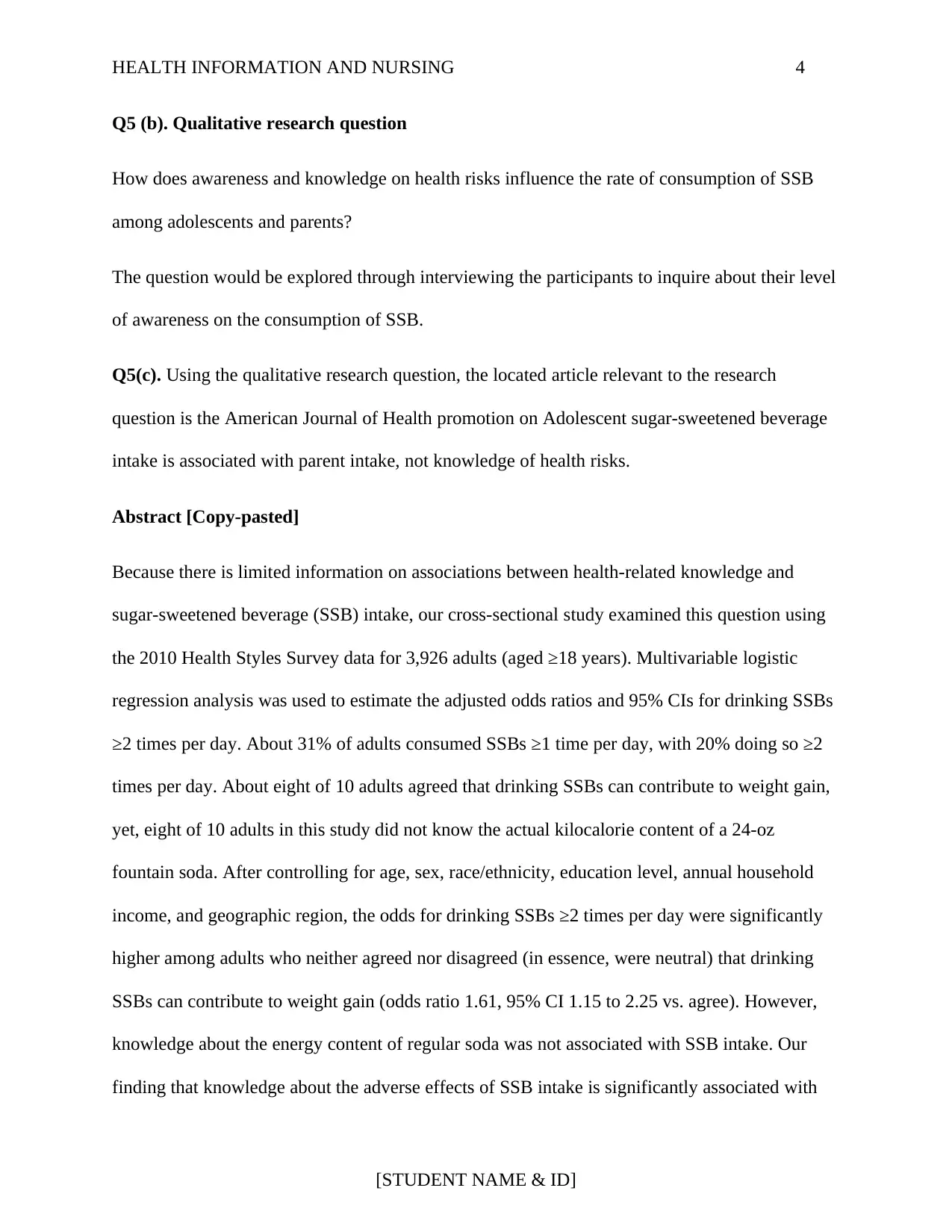
HEALTH INFORMATION AND NURSING 4
Q5 (b). Qualitative research question
How does awareness and knowledge on health risks influence the rate of consumption of SSB
among adolescents and parents?
The question would be explored through interviewing the participants to inquire about their level
of awareness on the consumption of SSB.
Q5(c). Using the qualitative research question, the located article relevant to the research
question is the American Journal of Health promotion on Adolescent sugar-sweetened beverage
intake is associated with parent intake, not knowledge of health risks.
Abstract [Copy-pasted]
Because there is limited information on associations between health-related knowledge and
sugar-sweetened beverage (SSB) intake, our cross-sectional study examined this question using
the 2010 Health Styles Survey data for 3,926 adults (aged ≥18 years). Multivariable logistic
regression analysis was used to estimate the adjusted odds ratios and 95% CIs for drinking SSBs
≥2 times per day. About 31% of adults consumed SSBs ≥1 time per day, with 20% doing so ≥2
times per day. About eight of 10 adults agreed that drinking SSBs can contribute to weight gain,
yet, eight of 10 adults in this study did not know the actual kilocalorie content of a 24-oz
fountain soda. After controlling for age, sex, race/ethnicity, education level, annual household
income, and geographic region, the odds for drinking SSBs ≥2 times per day were significantly
higher among adults who neither agreed nor disagreed (in essence, were neutral) that drinking
SSBs can contribute to weight gain (odds ratio 1.61, 95% CI 1.15 to 2.25 vs. agree). However,
knowledge about the energy content of regular soda was not associated with SSB intake. Our
finding that knowledge about the adverse effects of SSB intake is significantly associated with
[STUDENT NAME & ID]
Q5 (b). Qualitative research question
How does awareness and knowledge on health risks influence the rate of consumption of SSB
among adolescents and parents?
The question would be explored through interviewing the participants to inquire about their level
of awareness on the consumption of SSB.
Q5(c). Using the qualitative research question, the located article relevant to the research
question is the American Journal of Health promotion on Adolescent sugar-sweetened beverage
intake is associated with parent intake, not knowledge of health risks.
Abstract [Copy-pasted]
Because there is limited information on associations between health-related knowledge and
sugar-sweetened beverage (SSB) intake, our cross-sectional study examined this question using
the 2010 Health Styles Survey data for 3,926 adults (aged ≥18 years). Multivariable logistic
regression analysis was used to estimate the adjusted odds ratios and 95% CIs for drinking SSBs
≥2 times per day. About 31% of adults consumed SSBs ≥1 time per day, with 20% doing so ≥2
times per day. About eight of 10 adults agreed that drinking SSBs can contribute to weight gain,
yet, eight of 10 adults in this study did not know the actual kilocalorie content of a 24-oz
fountain soda. After controlling for age, sex, race/ethnicity, education level, annual household
income, and geographic region, the odds for drinking SSBs ≥2 times per day were significantly
higher among adults who neither agreed nor disagreed (in essence, were neutral) that drinking
SSBs can contribute to weight gain (odds ratio 1.61, 95% CI 1.15 to 2.25 vs. agree). However,
knowledge about the energy content of regular soda was not associated with SSB intake. Our
finding that knowledge about the adverse effects of SSB intake is significantly associated with
[STUDENT NAME & ID]
Paraphrase This Document
Need a fresh take? Get an instant paraphrase of this document with our AI Paraphraser
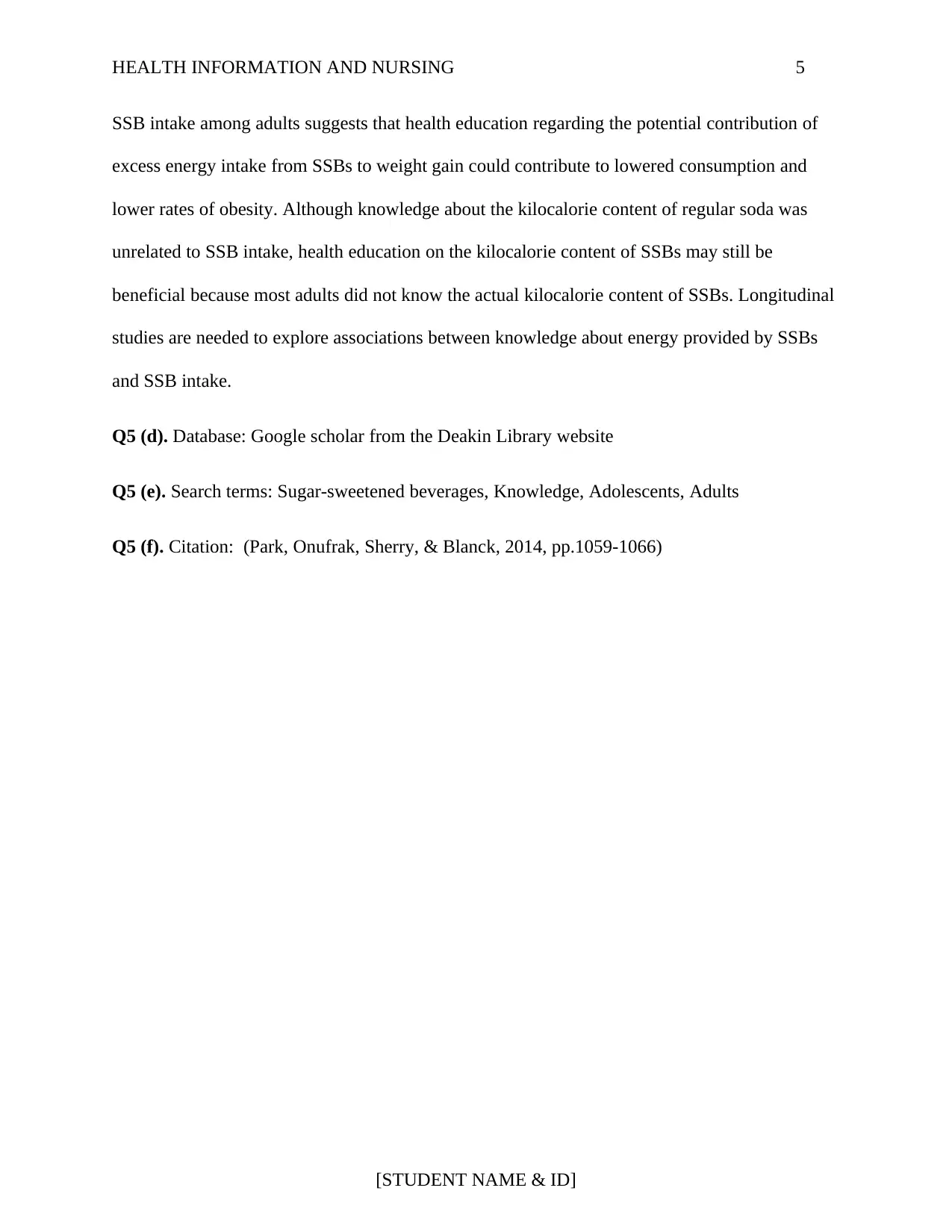
HEALTH INFORMATION AND NURSING 5
SSB intake among adults suggests that health education regarding the potential contribution of
excess energy intake from SSBs to weight gain could contribute to lowered consumption and
lower rates of obesity. Although knowledge about the kilocalorie content of regular soda was
unrelated to SSB intake, health education on the kilocalorie content of SSBs may still be
beneficial because most adults did not know the actual kilocalorie content of SSBs. Longitudinal
studies are needed to explore associations between knowledge about energy provided by SSBs
and SSB intake.
Q5 (d). Database: Google scholar from the Deakin Library website
Q5 (e). Search terms: Sugar-sweetened beverages, Knowledge, Adolescents, Adults
Q5 (f). Citation: (Park, Onufrak, Sherry, & Blanck, 2014, pp.1059-1066)
[STUDENT NAME & ID]
SSB intake among adults suggests that health education regarding the potential contribution of
excess energy intake from SSBs to weight gain could contribute to lowered consumption and
lower rates of obesity. Although knowledge about the kilocalorie content of regular soda was
unrelated to SSB intake, health education on the kilocalorie content of SSBs may still be
beneficial because most adults did not know the actual kilocalorie content of SSBs. Longitudinal
studies are needed to explore associations between knowledge about energy provided by SSBs
and SSB intake.
Q5 (d). Database: Google scholar from the Deakin Library website
Q5 (e). Search terms: Sugar-sweetened beverages, Knowledge, Adolescents, Adults
Q5 (f). Citation: (Park, Onufrak, Sherry, & Blanck, 2014, pp.1059-1066)
[STUDENT NAME & ID]
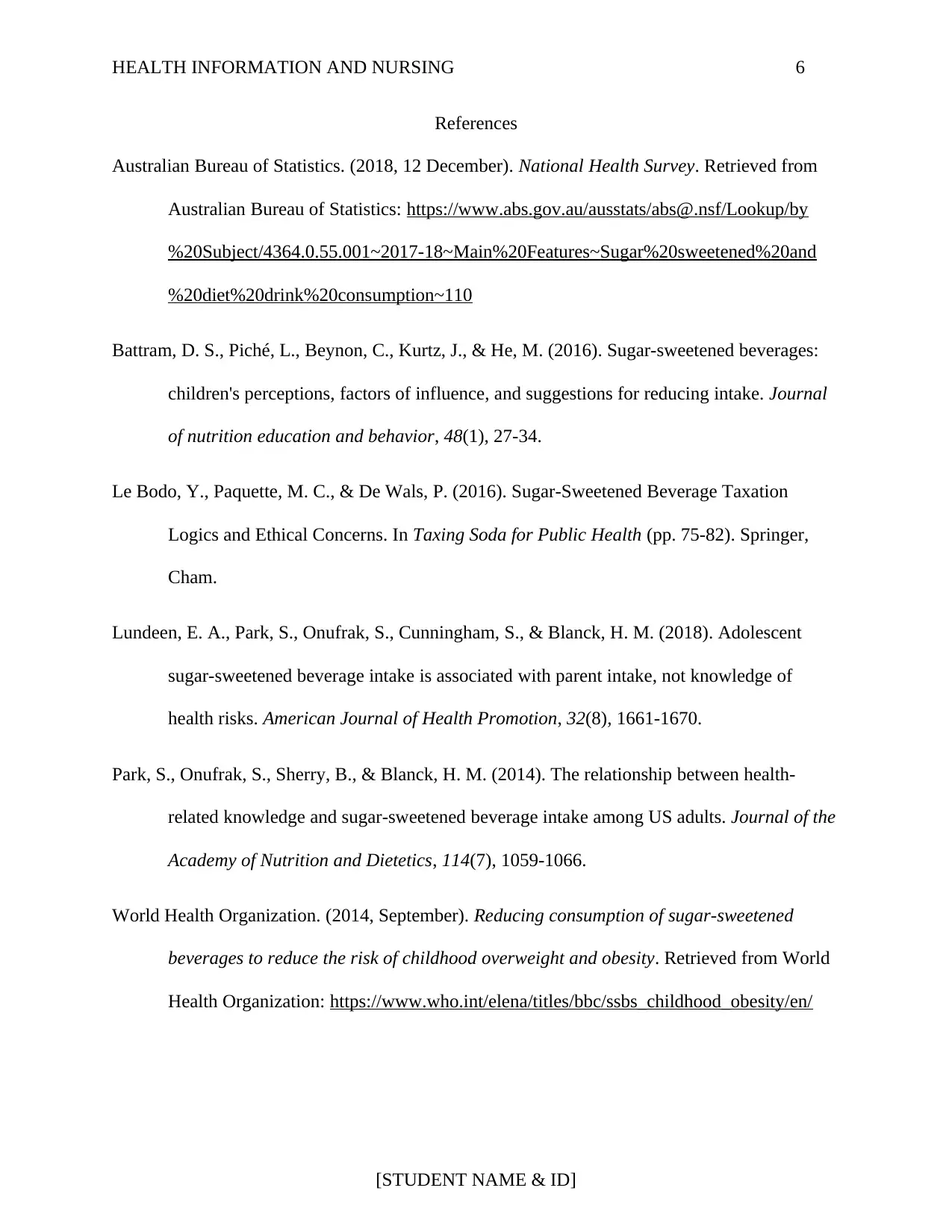
HEALTH INFORMATION AND NURSING 6
References
Australian Bureau of Statistics. (2018, 12 December). National Health Survey. Retrieved from
Australian Bureau of Statistics: https://www.abs.gov.au/ausstats/abs@.nsf/Lookup/by
%20Subject/4364.0.55.001~2017-18~Main%20Features~Sugar%20sweetened%20and
%20diet%20drink%20consumption~110
Battram, D. S., Piché, L., Beynon, C., Kurtz, J., & He, M. (2016). Sugar-sweetened beverages:
children's perceptions, factors of influence, and suggestions for reducing intake. Journal
of nutrition education and behavior, 48(1), 27-34.
Le Bodo, Y., Paquette, M. C., & De Wals, P. (2016). Sugar-Sweetened Beverage Taxation
Logics and Ethical Concerns. In Taxing Soda for Public Health (pp. 75-82). Springer,
Cham.
Lundeen, E. A., Park, S., Onufrak, S., Cunningham, S., & Blanck, H. M. (2018). Adolescent
sugar-sweetened beverage intake is associated with parent intake, not knowledge of
health risks. American Journal of Health Promotion, 32(8), 1661-1670.
Park, S., Onufrak, S., Sherry, B., & Blanck, H. M. (2014). The relationship between health-
related knowledge and sugar-sweetened beverage intake among US adults. Journal of the
Academy of Nutrition and Dietetics, 114(7), 1059-1066.
World Health Organization. (2014, September). Reducing consumption of sugar-sweetened
beverages to reduce the risk of childhood overweight and obesity. Retrieved from World
Health Organization: https://www.who.int/elena/titles/bbc/ssbs_childhood_obesity/en/
[STUDENT NAME & ID]
References
Australian Bureau of Statistics. (2018, 12 December). National Health Survey. Retrieved from
Australian Bureau of Statistics: https://www.abs.gov.au/ausstats/abs@.nsf/Lookup/by
%20Subject/4364.0.55.001~2017-18~Main%20Features~Sugar%20sweetened%20and
%20diet%20drink%20consumption~110
Battram, D. S., Piché, L., Beynon, C., Kurtz, J., & He, M. (2016). Sugar-sweetened beverages:
children's perceptions, factors of influence, and suggestions for reducing intake. Journal
of nutrition education and behavior, 48(1), 27-34.
Le Bodo, Y., Paquette, M. C., & De Wals, P. (2016). Sugar-Sweetened Beverage Taxation
Logics and Ethical Concerns. In Taxing Soda for Public Health (pp. 75-82). Springer,
Cham.
Lundeen, E. A., Park, S., Onufrak, S., Cunningham, S., & Blanck, H. M. (2018). Adolescent
sugar-sweetened beverage intake is associated with parent intake, not knowledge of
health risks. American Journal of Health Promotion, 32(8), 1661-1670.
Park, S., Onufrak, S., Sherry, B., & Blanck, H. M. (2014). The relationship between health-
related knowledge and sugar-sweetened beverage intake among US adults. Journal of the
Academy of Nutrition and Dietetics, 114(7), 1059-1066.
World Health Organization. (2014, September). Reducing consumption of sugar-sweetened
beverages to reduce the risk of childhood overweight and obesity. Retrieved from World
Health Organization: https://www.who.int/elena/titles/bbc/ssbs_childhood_obesity/en/
[STUDENT NAME & ID]
⊘ This is a preview!⊘
Do you want full access?
Subscribe today to unlock all pages.

Trusted by 1+ million students worldwide
1 out of 6
Related Documents
Your All-in-One AI-Powered Toolkit for Academic Success.
+13062052269
info@desklib.com
Available 24*7 on WhatsApp / Email
![[object Object]](/_next/static/media/star-bottom.7253800d.svg)
Unlock your academic potential
Copyright © 2020–2025 A2Z Services. All Rights Reserved. Developed and managed by ZUCOL.





